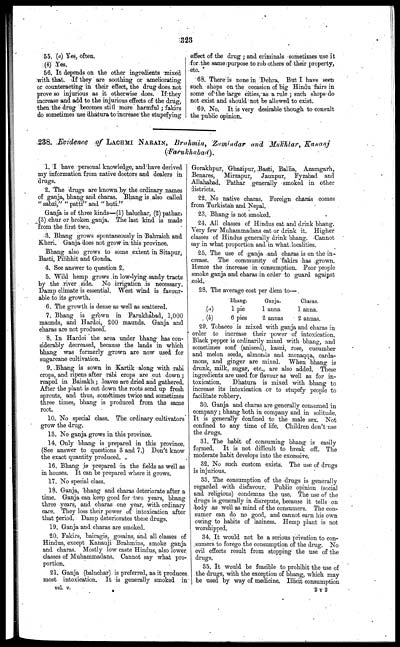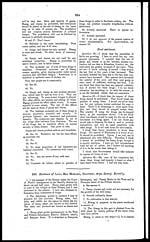Medicine - Drugs > Report of the Indian Hemp Drugs Commission, 1894-1895 > Volume V
(343) Page 323
Download files
Individual page:
Thumbnail gallery: Grid view | List view

323
55. (a) Yes, often.
(4) Yes.
56. It depends on the other ingredients mixed
with that. If they are soothing or ameliorating
or counteracting in their effect, the drug does not
prove so injurious as it otherwise does. If they
increase and add to the injurious effects of the drug,
then the drug becomes still more harmful; fakirs
do sometimes use dhatura to increase the stupefying
effect of the drug; and criminals sometimes use it
for the same purpose to rob others of their property,
etc.
68. There is none in Dehra. But I have seen
such shops on the occasion of big Hindu fairs in
some of the large cities, as a rule; such shops do
not exist and should not be allowed to exist.
69. No. It is very desirable though to consult
the public opinion.
238. Evidence of LACHMI NARAIN, Brahmin, Zamindar and Mukhtar, Kananj
(Farukhabad).
1. I have personal knowledge, and have derived
my information from native doctors and dealers in
drugs.
2. The drugs are known by the ordinary names
of ganja, bhang and charas. Bhang is also called
"sabzi," "patti" and "buti."
Ganja is of three kinds—(1) baluchar, (2) pathar,
(3) chur or broken ganja. The last kind is made
from the first two.
3. Bhang grows spontaneously in Bahraich and
Kheri. Ganja does not grow in this province.
Bhang also grows to some extent in Sitapur,
Basti, Pilibhit and Gonda.
4. See answer to question 2.
5. Wild hemp grows in low-lying sandy tracts
by the river side. No irrigation is necessary.
Damp climate is essential. West wind is favour-
able to its growth.
6. The growth is dense as well as scattered.
7. Bhang is grown in Farukhabad, 1,000
maunds, and Hardoi, 200 maunds. Ganja and
charas are not produced.
8. In Hardoi the area under bhang has con-
siderably decreased, because the lands in which
bhang was formerly grown are now used for
sugarcane cultivation.
9. Bhang is sown in Kartik along with rabi
crops, and ripens after rabi crops are cut down;
reaped in Baisakh; leaves are dried and gathered.
After the plant is cut down the roots send up fresh
sprouts, and thus, sometimes twice and sometimes
three times, bhang is produced from the same
root.
10. No special class. The ordinary cultivators
grow the drug.
13. No ganja grows in this province.
14. Only bhang is prepared in this province.
(See answer to questions 3 and 7.) Don't know
the exact quantity produced.
16. Bhang is prepared in the fields as well as
in houses. It can be prepared where it grows.
17. No special class.
18. Ganja, bhang and charas deteriorate after a
time. Ganja can keep good for two years, bhang
three years, and charas one year, with ordinary
care. They loss their power of intoxication after
that period. Damp deteriorates these drugs.
19. Ganja and charas are smoked.
20. Fakirs, bairagis, gosains, and all classes of
Hindus, except Kauauji Brahmins, smoke ganja
and charas. Mostly low caste Hindus, also lower
classes of Muhammadans. Cannot say what pro-
portion.
21. Ganja (baluchar) is preferred, as it produces
most intoxication. It is generally smoked in
Gorakhpur, Ghazipur, Basti, Ballia, Azamgarh,
Benares, Mirzapur, Jaunpur, Fyzabad and
Allahabad. Pathar generally smoked in other
districts.
22. No native charas. Foreign charas comes
from Turkistan and Nepal.
23. Bhang is not smoked.
24. All classes of Hindus eat and drink bhang.
Very few Muhammadans eat or drink it. Higher
classes of Hindus generally drink bhang. Cannot
say in what proportion and in what localities.
25. The use of ganja and charas is on the in-
crease. The community of fakirs has grown.
Hence the increase in consumption. Poor people
smoke ganja and charas in order to guard against
cold.
28. The average cost per diem to—
|
Bhang. |
Ganja. |
Charas. |
|
|
(a) |
1 pie |
1 anna |
1 anna. |
|
(b) |
6 pies |
2 annas |
2 annas. |
29. Tobacco is mixed with ganja and charas in
order to increase their power of intoxication.
Black pepper is ordinarily mixed with bhang, and
sometimes sonf (aniseed), kasni, rose, cucumber
and melon seeds, almonds and monaqqa, carda-
mons, and ginger are mixed. When bhang is
drunk, milk, sugar, etc., are also added. These
ingredients are used for flavour as well as for in-
toxication. Dhatura is mixed with bhang to
increase its intoxication or to stupefy people to
facilitate robbery.
30. Ganja and charas are generally consumed in
company; bhang both in company and in solitude.
It is generally confined to the male sex. Not
confined to any time of life. Children don't use
the drugs.
31. The habit of consuming bhang is easily
formed. It is not difficult to break off. The
moderate habit develops into the excessive.
32. No such custom exists. The use of drugs
is injurious.
33. The consumption of the drugs is generally
regarded with disfavour. Public opinion (social
and religious) condemns the use. The use of the
drugs is generally in disrepute, because it tells on
body as well as mind of the consumers. The con-
sumer can do no good, and cannot earn his own
owing to habits of laziness. Hemp plant is not
worshipped.
34. It would not be a serious privation to con-
sumers to forego the consumption of the drug. No
evil effects result from stopping the use of the
drugs.
35. It would be feasible to prohibit the use of
the drugs, with the exception of bhang, winch may
be used by way of medicine. Illicit consumption
vol. v. 2T2
Set display mode to: Large image | Zoom image | Transcription
Images and transcriptions on this page, including medium image downloads, may be used under the Creative Commons Attribution 4.0 International Licence unless otherwise stated. ![]()
| India Papers > Medicine - Drugs > Report of the Indian Hemp Drugs Commission, 1894-1895 > Volume V > (343) Page 323 |
|---|
| Permanent URL | https://digital.nls.uk/75121857 |
|---|
| Description | Volume 5: Evidence of witnesses from North-Western Provinces and Oudh and Punjab. Answers from witnesses in North-Western Provinces, Oudh and Punjab about cultivation and growth of hemp, preparation or manufacture, trade, consumption or use, effects, administration - taxation and control. |
|---|---|
| Attribution and copyright: |
|




